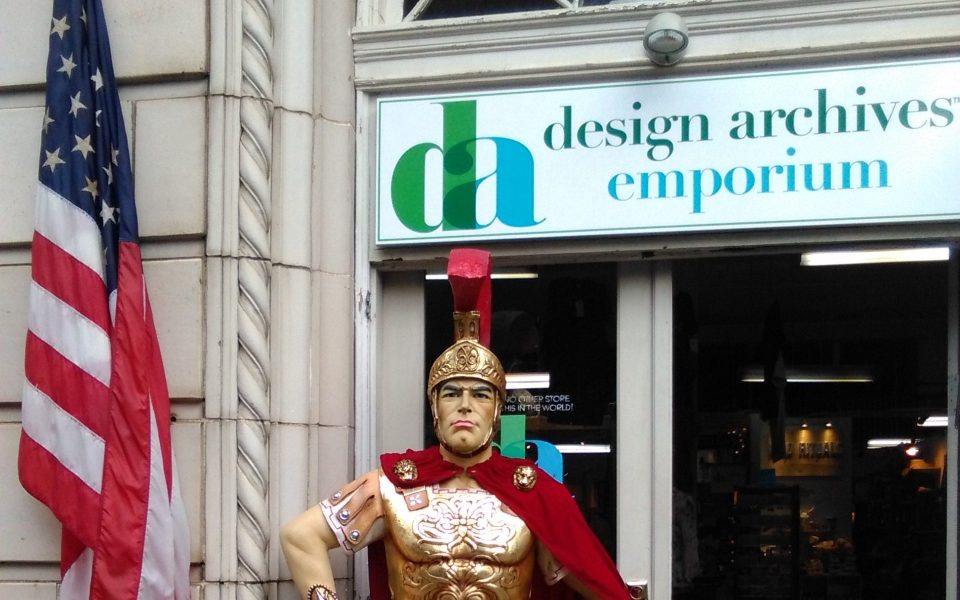The List: 6 of Design Archives’ most weirdly literary objects
1. Americanah (by Chimamanda Ngozi Adichie) swept into my mind as I browsed the Design Archives vendor booths on South Elm Street in Greensboro. The book recounts the sojourn of a Nigerian woman in the United States, who, having fled her country due to violence, discovers — and writes about — the many shades of American racial discord. It occurred to me while looking at non sequitur Americana, such as a painting of Jimi Hendrix hung adjacent to a cast iron set of Amish figurines, that all Americana, like America itself, stands as a marker to our own turbulent history of trying to live together. In a deep way, Americana is actually Americanah.
2. War and Peace (by Leo Tolstoy) came up for me in Greensboro, where the material remnants of conflict and the struggle for peace emerged on the shelves. Resting below a rack of colorful, flower-print maxi dresses from the Vietnam era, a pair of used combat boots stood out as a stark survival of wartime. As War and Peace the novel illustrates, global-level hostilities reach us all — even down to our clothes and shoes, some of the most personal, yet public-facing, objects we own.
3. The Icarus Girl (by Helen Oyeyemi), like Americanah, centers on Nigerian cultural experience and mythology. I felt like extrapolating those notions to American cultural mythology when I encountered a massive centurion statue guarding the Winston-Salem Design Archives door. Complete with red-brush helmet and mock sword, the figurine (which apparently originated in a Wilmington movie studio) loomed above me as an ironic meme of theatrical Americanism. Die Hard 6, anyone? Yeesh.
4. On Beauty (by Zadie Smith) considers intertwining themes of gender, religion, love andcultural conflict, on which I reflected while pondering another item in the Greensboro store. It’s called “The Lady Schick Haircurler with Beautifying Mist.” I’ll allow that title to speak for itself.
5. Pride and Prejudice (by Jane Austen) — the title at least — resonates with one of the more curious (and tattered) books I discovered in a dark nook at the Greensboro store. The title? Finger Lickin’ Good: The Story of Colonel Sanders, by L. Henry Dowell. From what I gather on the internet, the work is a kind of hagiography in praise of Sanders. Mic.com offers strong pushback on that narrative, reporting that “Colonel Sanders tried to elect America’s most infamous segregationist — George Wallace — to the presidency.” For me, this book served as another reminder that we Americans still have a long road to walk towards racial justice and reconciliation.
6. Orientalism (by Edward Said) isn’t a strictly literary work, but its argument filled my mind as I flipped through the stacks of Kennedy-era Life magazines at the Winston-Salem location. Said’s work asserts that Western culture erroneously casts non-Western cultures as “Oriental,” that is, mysterious, exotic and even illogical. Personally, I can’t think of a more irrational (and orientalist) cultural representation than the Life cover from 1961 that shows Elizabeth Taylor as Cleopatra. Yet, as weird as American material culture seems, it’s this very patchwork of memorabilia that survives us all.
Join the First Amendment Society, a membership that goes directly to funding TCB‘s newsroom.
We believe that reporting can save the world.
The TCB First Amendment Society recognizes the vital role of a free, unfettered press with a bundling of local experiences designed to build community, and unique engagements with our newsroom that will help you understand, and shape, local journalism’s critical role in uplifting the people in our cities.
All revenue goes directly into the newsroom as reporters’ salaries and freelance commissions.


Leave a Reply